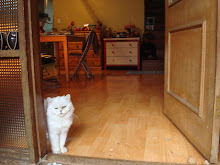 |
| 다문화 만두 - student style |
I love mandu also known as manti or mumtu, manty, gyoza or dumplings. My first mandu were at R's place when I was in my teens and they were hosting me in Gilgit, Northern Pakistan. Her grandmother was from Kashghar, Xinjiang, China and used to visit once a year and luckily I was there too.
 |
| Manti in Dongdaemun |
R's grandma made laghman (or hand-made noodles) and a couple of other dishes too and they were quite a treat then. Mandu and noodles can be found in kitchens around Northern Pakistan...and it's nothing weird. Since these areas are close to the Chinese border hence, the food culture may have fused at some point through travelers and traders. The baking of salted bread is very similar to a Russian bread I saw in Moscow or salted tea is also a common practice. An interesting thing the people of Northern Pakistan love to eat is the salted/dried beef which they prepare and process themselves at home...and that, I've never heard of in other parts of Pakistan. Use of sun-dried tomatoes and other vegetables is also a common practice since temperature are minus 15 to minus 50 Celsius, depending on the altitude and nothing can grow or is visible except snow during winter.
 |
| Japanese stall in Seoul |
Later on, when I got to live in Central Asia and Russia, I came across manti and Palmini etc. and a number of dishes that were common in Northern Pakistan, of course the tastes were slightly different but still, it surprised me. My most loved manti had a filling of squash and lamb's meat with the only seasoning to be that of salt and black pepper.
 |
| Potatoes, Rice Cake and Kimchi Mandu - it is Halal! |
In Dongdaemun, Insadong and Ansan, I have been able to find halal mandu. I have tried seafood manu and shrimp mandu in Insadong but such places are very few. I have also tried vege and tofu filled mandu. These days, companies are selling hobak-khamja mandu (with a filling of pumpkin and potatoes) or kimchi and potato filling, I saw freezers packed with them to be sold at Lotte Mart.
 |
| In the end, I was fed up with my mandu folding style and then I simply pressed the corners of the mandu skin - they r ready to go in a freezer. |
I had a craving for mandu and of course, I wasn't ready to eat out in Dongdaemun in this crazy cold. After being inspired by a friend from China, who made a couple of dozen of mandu on new year, I have also tried my hand on making mandu last night.
 |
| Home-made Chinese mandu |
Mandu wraps calledㅡMadnu Phi (만두 피) is sold at every store for about 1200 won (50 sheets) or a dollar a pack. I made filling of potatoes, finely chopped cabbage, spring onion, tofu and paprika and seasoned it with cumin, black pepper and salt. After making 15 mandu I gave up! Every mandu was different from the other in shape. A friend called them 'multicultural mandu'...다문화 만두!
 |
| Mandu on extreme right is made by a Mongol student and it was the prettiest |
In killer winters, like this year here in Korea, mandu-kuk (soup) is such a treat. I made mine in combination with rice noodles and it was awesome.
 |
| Mandu -kuk |
I think that it would be fun and a treat to see if one can wrap them nicely...I couldn't and it made me feel bad however, their taste was great!
 |
| Finally.... |
My preparation and cooking time was 40 minutes.
I have about 10 extra mandu in the freezer so it will hardly take 5 or 10 minutes for my mandu -kuk next time! I also made some vinaigrette to add to my mandu soup and it enhanced the taste manifold.
Last but not the least, I'd highly recommend you to read this very comprehensive article at Visit Seoul HERE. BTW. unless otherwise mentioned, every mandu has pork in it even if it is called "Yachae (야채 만두) mandu" - at small takeout restaurants, hence be watchful.
If you are new to Korea then you can learn a few important phrases in case you eat halal or you are a vegetarian, ask a friend to write it for you, just in case. Here are the basic questions that you might help you:
Is there pork in this? or 여기서 돼지고기들어가요?
Yogi seo thae-ji gogi duro-gayo?
You can simply ask somebody to write for you this:
I don't eat pork or 나는 돼지고기 를 안먹어요!
Na -nun thae-ji gogi rul um-mo-go-yo.
Go through this blog: Korean Class 101 and probably you will find a lot of basic, survival phrases.
Best of luck!












